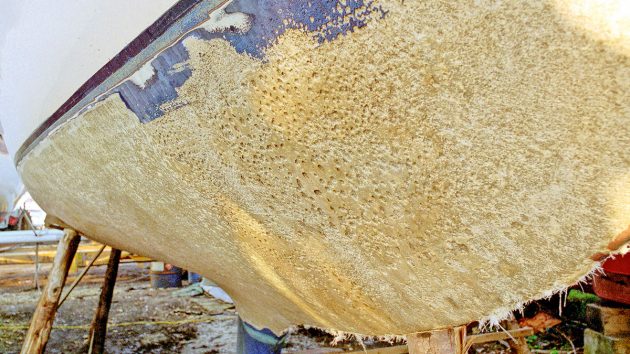When does boat osmosis need treating? PBO reader Alastair Hutchison Dorchester asked our experts
I have a 1981 Westerly Vulcan which has been out of the water in Poole now for over 18 months having a new engine installed plus a bow thruster.
It’s almost ready to go back to the marina and one of the last jobs is to antifoul the hull.
The hull has quite a few osmosis blisters, although none bigger than about 4mm diameter.
The shipwright who has done most of the work for me is advising to just slap three coats of antifouling on it because the hull is thick enough to not worry about it.

Soda or slurry blasting are among the quickest ways to remove gel coat from a hull. A surveyor can then assess how bad the boat osmosis is
On the other hand I’m thinking that the hull at present is really dry – we haven’t had anything but sunshine now for around 10+ weeks.
So I’m wondering if I should use an antifoul with an epoxy-based primer, although the downside is that I would need a lot of hull preparation first.
Would this be of any benefit to the osmosis? Or do I just do the easy thing and get it in the water as soon as I can?
Alastair Hutchison Dorchester, Dorset
Richard Jerram replies:
Out of the water for 18 months your Westerly Vulcan hull should have significantly dried out, and as you have osmotic blistering that indicates moisture has penetrated the hull in the past.
As the hull will only have a small amount of moisture as you write, I can see no reason why you couldn’t just apply two coats of antifouling and go back into the water and enjoy the rest of the season.
Continues below…
DIY Osmosis Repair
If you’ve found a few blisters on your gel coat, don’t despair. You may not need to do a full…
Watch PBO video: How to prevent osmosis
PBO practicals editor, Jake Kavanagh, demonstrates using International Gelshield to prevent osmosis
How to prevent osmosis blisters on your yacht’s hull
Here you can see Jake Kavanagh's step-by-step demonstration of how to prepare your hull for a coat of Gelshield
However I’d not ignore these blisters and would recommend that the yacht comes out of the water at the end of the season and the blistering is given some attention.
If you ignore them they’ll almost certainly get bigger and become fluid filled.
Assuming they are throughout the hull you’ll probably have to have the gelcoat removed and an epoxy system applied.
Removing gelcoat is a big job and you may want to have it done by soda blasting or gel planing – which is really a job for the professionals.
To ascertain how severe the blistering is it would be worth having a yacht surveyor take a look who’d be able to recommend the best solution.
Enjoyed reading When to treat boat osmosis?
A subscription to Practical Boat Owner magazine costs around 40% less than the cover price.
Print and digital editions are available through Magazines Direct – where you can also find the latest deals.
PBO is packed with information to help you get the most from boat ownership – whether sail or power.
-
-
-
- Take your DIY skills to the next level with trusted advice on boat maintenance and repairs
- Impartial in-depth gear reviews
- Practical cruising tips for making the most of your time afloat
-
-






